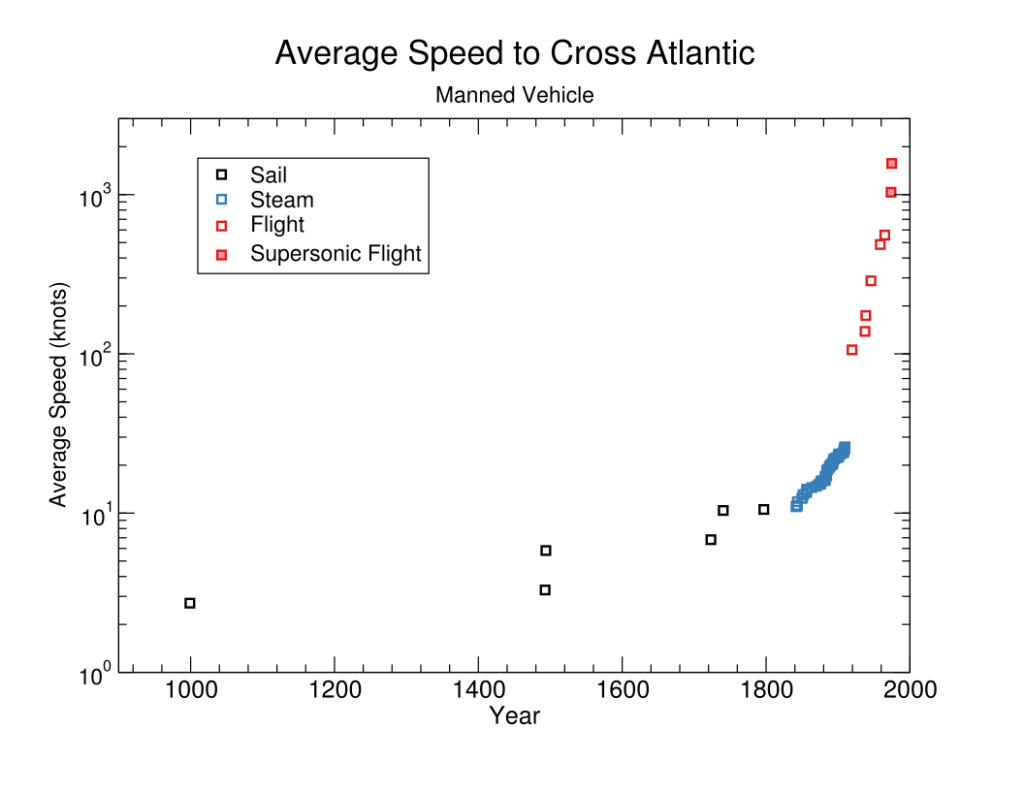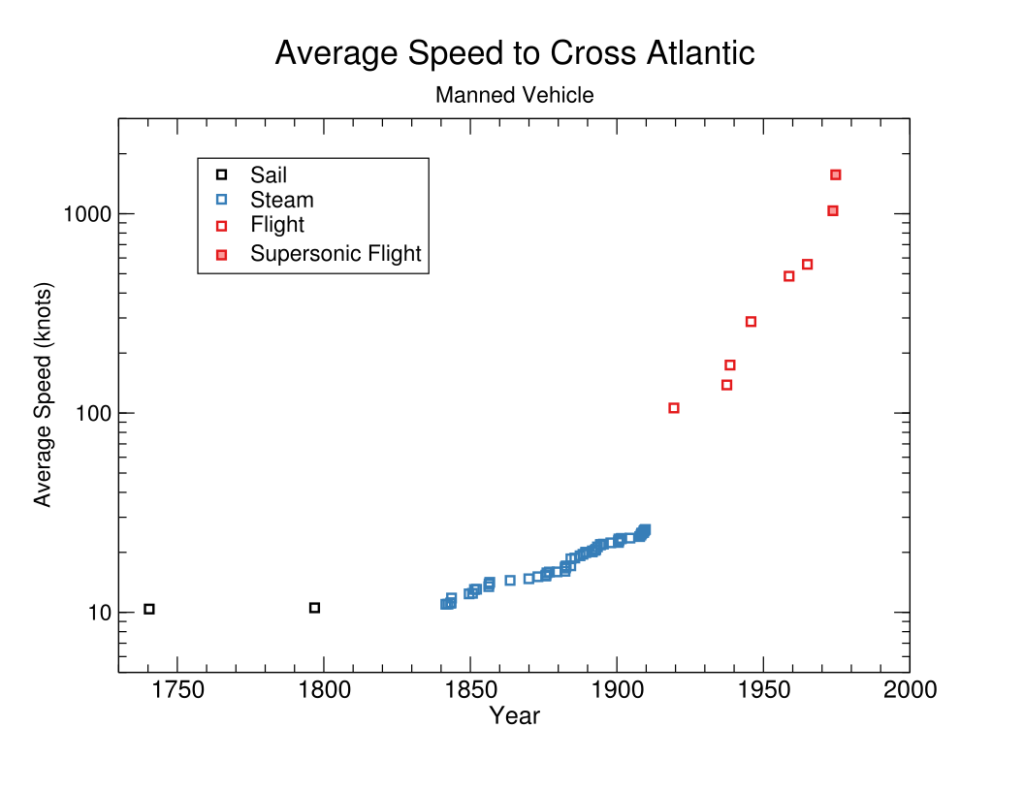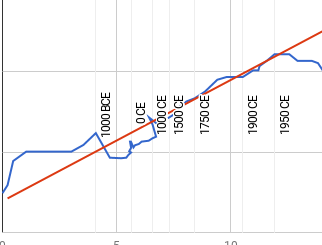The speed of human travel across the Atlantic Ocean has seen at least seven discontinuities of more than ten years’ progress at past rates, two of which represented more than one hundred years’ progress at past rates: Columbus’ second journey, and the first non-stop transatlantic flight.
Details
This case study is part of AI Impacts’ discontinuous progress investigation.
Trends
Transatlantic passenger crossing speed
We investigated fastest recorded passenger trips across the Atlantic Ocean over time. By ‘passenger’ we mean that any human made the crossing, or could have done.
We look for fastest speeds of real historic systems that could have with high probability delivered a live person across the Atlantic Ocean. We do not require that a person was actually sent by the method in question, though in fact all of our records did involve a passenger traveling.
We generally use whatever route was actually taken (or supposed in an estimate), and do not attempt to infer faster speeds possible had an optimal route been taken (though note that because we are measuring speed rather than time to cross the Ocean, route length is adjusted for to a first approximation).
Data
We collated records of historic speeds to cross the Atlantic Ocean from online sources.1 These are available at the ‘Passenger’ tab of this spreadsheet, and are shown in Figure 1 below. We have not verified this data.
Detailed overview of data
We collected some data on speeds of drifting across the Atlantic Ocean and Viking ship speeds as evidence about the previous trend, but do not look for discontinuities until Columbus’ trips, for which relatively detailed descriptions are available.
Between then and 1841 the fastest records of transatlantic crossings we know of come from Slavevoyages.org‘s database of over thirty six thousand voyages made by slave ships. We combined this data with distances between recorded ports for trips that might plausibly be fastest, to find speed records. This produced only three record trips. These were substantial outliers in speed, which suggests to us that those records may have been driven by error, or may have involved different types of ship or circumstances to the others. The latter explanation would suggest that faster trips were likely made for purposes other than slave transport, meaning that these slave trips were unlikely to represent discontinuities in crossing speed across all types of ship. Given this, and that we do not have data for other types of ship at that time, we do not measure discontinuities during this period. We do include these ships to estimate the longer term trend, for measuring later discontinuities. The existence of later discontinuities does not appear to be sensitive to whether we include outlier slave ships in the historic trend, or replace them with more credible slower slave ships.
From 1841 to 1909 all of our records are from Wikipedia’s page, Blue Riband. That page describes the Blue Riband was ‘an unofficial accolade given to the passenger liner crossing the Atlantic Ocean in regular service with the record highest speed’. It appears that this title was sought after, and the records during that time are dense, so this part of the dataset is probably relatively accurate and complete for passenger steam ships. The main potential gap in this data is that we cannot be sure there are not other types of boat at the time that traveled faster than passenger steam ships.
From the first flight in 1919, speed records were held by planes. We found these in a variety of places, and we judged the data to be relatively complete when we ceased to find new records with moderate searching.
We are particularly interested in avoiding missing data just before apparent discontinuities, since continuous progress may look discontinuous if data is missing. There is a fifteen year gap before the Concorde discontinuity in 1973 where we didn’t find any records. However we note that a record for fastest subsonic Atlantic crossing set in 1979 was substantially slower than the Concorde. This means that if there were no other supersonic transatlantic crossings prior to the Concorde, the Concorde must have been substantially faster than the previous record even if we were missing some data. For instance if we were missing a 1965 record as fast as the 1979 record (which might make sense, since the 1979 record was set by a 1965 aircraft), then the Concorde would still be a discontinuity of around twenty years. We could not find other supersonic transatlantic crossings, but cannot rule them out.


Discontinuity measurement
We measure discontinuities by comparing progress made at a particular time to the past trend. For this purpose, we treat the past trend at any given point as exponential or linear depending on apparent fit, and judge a new trend to have begun when the recent trend has diverged sufficiently from the longer term trend. See our spreadsheet, tab ‘Passenger’ to view the trends we break this data into, and our methodology page for details on how to interpret our sheets and how we divide data into trends.
Given these judgments about past progress, there were seven greater than 10-year discontinuities during the periods that we looked at, summarized in the following table.2 Two of them were large (more than one hundred years of progress at previous rate).
| Date | Mode of transport | Knots | Discontinuity size (years progress at past rate) |
| 1493 | Columbus’ second voyage | 5.8 | 1465 |
| 1884 | Oregon (steamship) | 18.6 | 10 |
| 1919 | WWI Bomber (first non-stop transatlantic flight) | 106 | 351 |
| 1938 | Focke-Wulf Fw 200 Condor | 174 | 19 |
| 1945 | Lockheed Constellation | 288 | 25 |
| 1973 | Concorde | 1035 | 19 |
| 1974 | SR-71 | 1569 | 21 |
In addition to the sizes of these discontinuity in years, we have tabulated a number of other potentially relevant metrics here.3
Discussion of causes
The first measured discontinuity comes from Columbus’ second voyage being much quicker than his first. We expect this is for non-technological reasons, such as noise in crossing times (such that if there had been a longer history of crossing, Columbus’ first voyage would not have been record-setting), Columbus’ crew benefiting from experience, and the second voyage being intended to reach its destination rather than doing so accidentally.
The largest discontinuity we noted (352 years at previous rates) came from the first non-stop transatlantic flight, in 1919.4 This represented a relatively fundamental change in the means of crossing the Atlantic, supporting the hypothesis that discontinuities tend to be associated with more fundamental technological progress.
We have not investigated the significance of the developments underlying the other smaller discontinuities.
During the Blue Riband period, attention appears to have been given to Atlantic crossing speed in particular, suggesting that more effort may have been directed to this metric then. During the later era of flight, record Atlantic crossing time appears to have been less of a goal.5 This, in combination with the much more incremental progress in the earlier era, weakly supports the hypothesis that discontinuities are associated with metrics that receive less attention.
Notes
- See the ‘Passenger’ tab of this spreadsheet for our sources.
- See our methodology page for more details, and our spreadsheet, tab ‘Passenger’ for our calculation.
- See our methodology page for more details.
- “British aviators John Alcock and Arthur Brown made the first non-stop transatlantic flight in June 1919. They flew a modified First World War Vickers Vimy bomber from St. John’s, Newfoundland, to Clifden, Connemara, County Galway, Ireland.” – “Transatlantic Flight Of Alcock And Brown”. 2019. En.Wikipedia.Org. Accessed June 25 2019. https://en.wikipedia.org/w/index.php?title=Transatlantic_flight_of_Alcock_and_Brown&oldid=902818541.
- For instance, the fastest crossing for a subsonic airliner achieved in 1979 was done in a 1965 plane, suggesting that such a record could plausibly have been set earlier (and before 1973 it would have been the record for any kind of flight, not just subsonic). The captain’s description also makes the attempt sound like it was unplanned and motivated by thinking it sounded feasible not long before, rather than a major effort. (See sheet for sources.)


